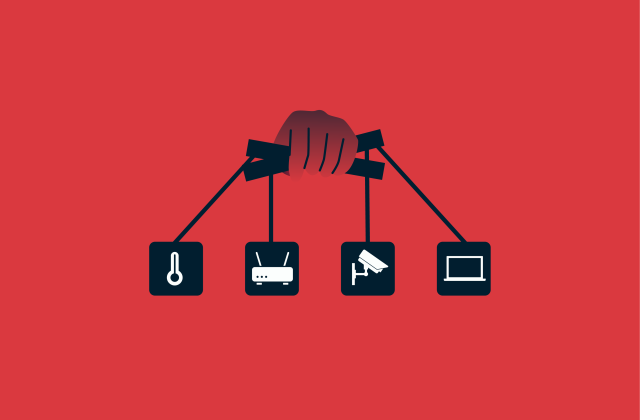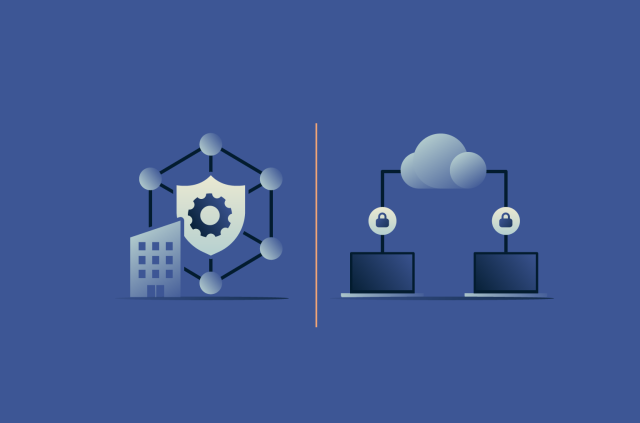What is first-party data

First-party data is information a company collects directly from people who use its website, app, or services.
This includes data collected with consent, like optional cookies, as well as information gathered through routine interactions such as purchases or account activity. Some first-party data, such as essential cookies needed for core functionality, may not require consent under certain privacy laws.
Because first-party data reflects real user behavior, many businesses consider it one of the most reliable sources for understanding their audience and improving services.
In this article, we look at why first-party data matters and how businesses collect and use it.
Why first-party data matters
First-party data helps companies understand how people actually use their products. It shows which features get the most use, where users run into issues, and what can be improved.
Businesses rely on this information to make websites and apps easier to navigate and more relevant to their audience.
First-party data doesn’t always stay within the company that collects it. How it’s stored, used, or shared depends on the company’s policies. Understanding this gives you a clearer view of both its benefits and the privacy considerations involved.
Examples of first-party data
The examples below are common types of customer data.
| Type of data | Description |
| Demographic information | Age, gender, marital status, occupation, and income. |
| Location data | Where users live, work, or access a business. |
| Purchase history | Previous transactions, subscriptions, and spending patterns. |
| Website behavior | Pages visited, time spent on page, and clicks made. |
| Loyalty programs and membership status | Insights into points, tier levels, and perks. |
| Coupon and discount usage | How often customers use promo codes and which deals they prefer. |
| Interests and preferences | Favorite products, preferred communication channels, or content choices. |
| Customer support interactions | Chat logs, past issues, and product returns. |
How first-party data is collected
First-party data is gathered through the actions you take while using a service. Common collection methods include:
- Account details: Entering information when you create or update an account, such as an email or username.
- Service interactions: The service records basic events such as logging in or using features inside the app or website. This helps it understand general usage patterns.
- Cookies and saved settings: First-party cookies help a service recognize returning users and link new activity to past visits. This allows the website to collect continuous first-party data, such as preferences, login status, or items left in a shopping cart. Some services also use browser fingerprinting to recognize returning visitors, though this technique raises additional privacy considerations because it can identify users without cookies.
- Purchases and interactions: Shopping, subscribing, leaving reviews, or adjusting settings all generate first-party data tied to your account.
- Device information: Your browser or operating system sends technical details that help the service work, such as your device type or language settings.
How first-party data is used across digital services
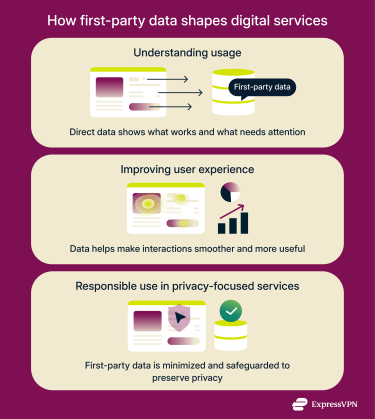 First-party data helps digital services see which features are popular, which pages load slowly, and where users run into problems. Because the data comes directly from real activity, it gives companies a clear picture of what’s working and what needs attention. This allows them to improve website design, optimize app features, and deliver more relevant content or recommendations to users.
First-party data helps digital services see which features are popular, which pages load slowly, and where users run into problems. Because the data comes directly from real activity, it gives companies a clear picture of what’s working and what needs attention. This allows them to improve website design, optimize app features, and deliver more relevant content or recommendations to users.
| Type of data | Example |
| Demographic information | A fitness brand might ask for a customer’s age and gender to suggest tailored workout programs or class recommendations. |
| Location data | An app could show nearby stores and highlight promotions available at that specific location. |
| Purchase history | An online bookstore can see that you often purchase mystery novels and recommend new releases in that genre. |
| Website behavior | A streaming service might notice frequent jazz searches and recommend similar music. |
| Loyalty programs and membership status | A coffee chain might track how often you buy drinks, what you typically order, and when you visit most, then use that data to offer personalized discounts or rewards. |
| Coupon and discount usage | A store might track which discount codes a customer redeems and suggest similar deals. |
| Interests and preferences | A gaming platform might track which genres a user plays most often and suggest new games that match their interests. |
| Customer support interactions | An e-commerce retailer might review previous support tickets to suggest solutions or product replacements tailored to a customer’s issue. |
Improving user experience
Services use first-party data to make everyday interactions smoother and more useful. Basic details such as which buttons you click or how long a page takes to load help teams identify friction points. With this information, they can simplify menus, speed up performance, and fix confusing layouts. The goal is to improve the flow of the service so that you spend less time struggling and more time getting value from it.
Supporting analytics and service optimization
First-party data also plays an important role in analytics. Companies look at patterns such as the most visited sections of an app or the average time spent on a feature. These insights guide decisions about updates, new tools, and long-term improvements. By studying direct user activity, teams can focus resources on changes that provide real benefits rather than guessing what people want.
Ensuring reliable and secure service operations
Privacy-focused services use first-party data to maintain performance and keep their systems running smoothly. This can include information needed to monitor server load, understand error reports, or troubleshoot issues.
They do this while limiting what data is stored, securing the data they collect, and being transparent about their practices. The aim is to support essential operations while respecting user privacy, security, and anonymity.
First-party data vs. other types of data
Other types of data come from outside sources and can be shared, purchased, or collected in indirect ways. Non-first-party data can move through multiple parties, making it harder to understand how it was collected or how accurate it is.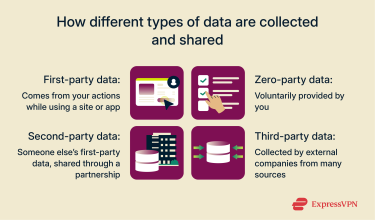
First-party vs. zero-party data
Zero-party data is information you intentionally and proactively provide to a service. This can include answering a survey, selecting interests in a profile, or telling a brand what you prefer.
Note: Information you provide because a service requires it, such as creating an account, is generally considered first-party data because it’s necessary for the service to function and not volunteered as a preference.
First-party vs. second-party data
Second-party data is another company’s first-party data that is shared through a partnership. For example, two businesses may exchange customer insights if they work in related industries. You don’t interact with the second company directly, yet your information may still reach them through the formal relationship.
First-party vs. third-party data
Third-party data comes from outside organizations that collect information from many different sources. These companies gather browsing patterns or general interests across the web and then sell or share that information. It doesn’t come from your direct use of a service.
How users can manage or limit first-party data collection
Managing first-party data is easier when you understand the tools available to you. The steps below outline practical ways you can control what information a website or app collects, stores, and processes.
Reviewing privacy settings on websites and apps
Some services give you a dedicated privacy or account setting page where you can control what information is collected during normal use. These settings sometimes let you turn off activity tracking, limit personalization ads, or stop certain data from being collected. Checking these options from time to time helps you control what a website or app learns from your actions.
Controlling cookie preferences
First-party cookies come directly from the site you are visiting and support everything from essential site functions to optional tools that help improve the experience. Many websites now offer cookie preference tools that let you disable optional categories such as analytics or personalization. Adjusting these settings reduces how much activity is recorded while still allowing the site to work properly.
Understanding consent banners and tracking notices
When you visit a site for the first time, you may see a banner asking whether the site can collect certain types of data. These banners are required by privacy laws such as the ePrivacy Directive for non-essential cookies and similar tracking technologies, while the General Data Protection Regulation (GDPR) defines how consent must be collected and managed.
Choosing “reject” or selecting only the necessary options limits the amount of optional first-party data the site can gather. It doesn’t stop all collection, since some basic information is still shared automatically by your browser, such as device type, operating system, or display settings, to make websites work properly. Browser fingerprinting techniques can also combine these details to recognize returning visitors.
That said, taking a moment to read these notices helps you make clearer choices about how much information you share when browsing.
Security practices that protect first-party data
Strong security practices help keep first-party data safe inside a service. These measures focus on protecting information while it moves, controlling who can see it and removing it when it’s no longer needed.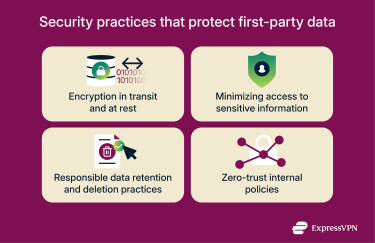
Encryption in transit and at rest
Encryption keeps data unreadable to anyone who shouldn’t see it. Services typically use two types:
- Encryption in transit: Protects data while it travels between your device and a service.
- Encryption at rest: Protects stored data so it stays secure even if someone accesses the storage system.
A combined approach is also used and, in most cases, is preferable, as it ensures attackers can’t interpret the information while it’s stored or transmitted. This method is standard across many online services.
Minimizing access to sensitive information
Minimizing access means controlling which apps, devices, and services can see first-party data. This helps reduce unnecessary exposure and keeps sensitive information safer. Common practices include:
- Allow employees to see only what they need: Organizations apply the principle of least privilege, ensuring staff access only the data required for their specific job roles.
- Use access logs: Recording internal activity through audit logs helps track who accessed what data and when, supporting compliance and security monitoring.
- Apply strict rules for approving new access requests: Access to first-party data is granted only after thorough review and approval, ensuring that only authorized individuals or systems can view or use the data.
Data retention and deletion practices
Personal information should be deleted once it’s no longer needed for the service or for any legal or operational requirements. Holding onto unnecessary data increases cybersecurity risks because the more information stored, the greater the chance of exposure.
In some cases, data may be anonymized instead of deleted, meaning it’s processed so it can generally no longer be linked to any individual.
Privacy regulations, such as the GDPR, give users the right to request the deletion of their data, so having a prepared infrastructure for this is also important for compliance.
Why zero-trust internal policies protect user data
Zero trust means that access inside a company is never assumed by default. Each request to view systems or data must be verified, even for internal staff. This approach assumes that threats can come from both inside and outside the company, adding an extra layer of protection for your information.
Core practices used to protect user data include:
- Never trust, always verify: Every request to access first-party data is carefully checked, even from internal staff, ensuring only authorized personnel can view or use information you’ve directly provided.
- Least privilege access: Employees and systems are given access only to the first-party data they need for their role, minimizing the risk that sensitive user information is exposed unnecessarily.
- Continuous verification: Access to first-party data is regularly reassessed based on factors like device security, user behavior, and other contextual signals, keeping protections up to date.
- Microsegmentation: Systems storing first-party data are divided into separate zones, so if a breach happens in one area, information in other zones remains protected.
Common misconceptions about first-party data
“First-party data means full tracking” (false)
First-party data is simply information gathered through the actions you take while using a service. Companies may collect only what is necessary for their services, depending on their policies, although many services also track non-essential activity for analytics, personalization, or advertising. At the same time, many features can still function without tracking every click or action.
“First-party data is always personal data” (not necessarily)
Many people assume first-party data always includes personal details, such as a name, email, or phone number. In reality, a service only collects personal information if you provide it directly. First-party data can include both identifiable and non-identifiable information, depending on how you use the website or app.
“First-party data can’t be shared” (not true; it depends on the context)
Some believe that first-party data can never be shared outside the company. This isn’t accurate. First-party data can be shared under certain conditions, such as when required for service operation, when legally mandated, or when proper consent has been obtained for optional sharing.
“First-party data is automatically safe” (depends on practices)
First-party data can be at risk if companies don’t use strong security practices, like encryption, access controls, and secure deletion. The safety of your information depends entirely on how it’s handled, not on the fact that it was collected firsthand.
FAQ: Common questions about first-party data
What’s the difference between first-party and third-party data?
First-party data is collected directly by the service you use, while third-party data comes from outside sources. Third-party providers gather information from multiple websites or apps and sell it to other companies. First-party data is generally more accurate and under the provider’s control, which can make it safer and more reliable for improving the service without tracking you across the web.
Is first-party data considered personal data?
First-party data can include both identifying and non-identifying information, including things like preferences or usage patterns, depending on whether they’re linked to your account or device.
Can first-party data be anonymous?
First-party data can be collected in an anonymous form, meaning it can’t be linked to a specific individual. Companies often use anonymized data to understand trends and improve services without storing personally identifying details. Anonymizing data helps reduce privacy risks while still allowing businesses to analyze user behavior.
Can first-party data be shared with other companies?
First-party data can be shared under certain conditions, depending on consent, contracts, or legal requirements. For example, a company may share anonymized or aggregated first-party data with partners for research or service improvements. Sharing is generally controlled to ensure privacy and compliance with regulations.
How does first-party data relate to the GDPR and other privacy laws?
First-party data is subject to privacy laws like the General Data Protection Regulation (GDPR). These regulations require companies to handle personal data responsibly, provide transparency, and offer users rights such as access, correction, and deletion. Compliance ensures that first-party data is collected and used in a way that respects privacy.
Is first-party data more secure than third-party data?
First-party data can be more secure than third-party data, but only if proper security practices are followed. Since it’s collected directly from users, companies have more control over storage, access, and protection measures. Note that security depends on encryption, access controls, and deletion practices rather than the data type itself.
How can I reduce the amount of first-party data collected about me?
You can limit first-party data collection by adjusting your account settings and privacy preferences. Many apps and websites allow you to opt out of certain types of data collection or minimize the information you provide. Being selective about what you share and using privacy-conscious tools can help reduce the data footprint companies collect.
Does first-party data always improve user experience?
First-party data can enhance user experience, but not automatically. When used responsibly, it helps companies personalize content, recommend products, and streamline services based on your preferences. However, poor handling or overcollection can create privacy risks.
Take the first step to protect yourself online. Try ExpressVPN risk-free.
Get ExpressVPN




